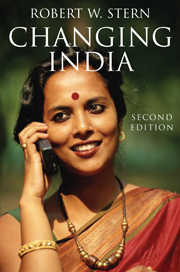Book contents
- Frontmatter
- Contents
- List of maps and tables
- Preface to the second edition
- Glossary
- Introduction: Change, the societies of India and Indian society
- Part I The changing countryside
- Part II Change from above
- 5 British imperialism, Indian nationalism and Muslim separatism
- 6 The Indian Union in a changing India
- Appendix One Major political events in the related histories of British imperialism and Indian nationalism, 1858–1947
- Appendix Two Major political events in the history of the Indian Union, 1947–2002
- Notes
- Guide to further reading
- Index
5 - British imperialism, Indian nationalism and Muslim separatism
Published online by Cambridge University Press: 18 April 2011
- Frontmatter
- Contents
- List of maps and tables
- Preface to the second edition
- Glossary
- Introduction: Change, the societies of India and Indian society
- Part I The changing countryside
- Part II Change from above
- 5 British imperialism, Indian nationalism and Muslim separatism
- 6 The Indian Union in a changing India
- Appendix One Major political events in the related histories of British imperialism and Indian nationalism, 1858–1947
- Appendix Two Major political events in the history of the Indian Union, 1947–2002
- Notes
- Guide to further reading
- Index
Summary
To argue that bourgeois revolution in India was the consequence of British imperialism and Indian nationalism is really one argument of related parts, certainly from the last decades of the nineteenth century. From then and for the next half-century or so until Independence, India's history unfolded largely in response to the intricate interplay between and within the forces of imperialism and nationalism. One consequence, in part, of the exchange, now marked by Pakistan and Bangladesh on the map of the subcontinent and on the consciousness of its inhabitants, was Muslim separatism.
British imperialism
Nowadays, students of modern Indian history are routinely cautioned against regarding the British imperial enterprise in India as a monolith. And indeed it was not a monolith. There was Her Majesty's Government in London under whose ultimate authority India was governed. But of its concerns, governing India was only one, and rarely a major one. The secretary of state for India was the concerned minister. But his concerns had to contend with those of other ministers and correspond with the interests, electoral and otherwise, of the government. There was a British government of India in Calcutta until 1911 when it shifted to Delhi. It was headed by a titled British politician, the Viceroy and Governor-General. In organizational theory, he was the Secretary of State's man in India. In practice, relationships between the two men and their governments were negotiated.
- Type
- Chapter
- Information
- Changing IndiaBourgeois Revolution on the Subcontinent, pp. 131 - 170Publisher: Cambridge University PressPrint publication year: 2003



